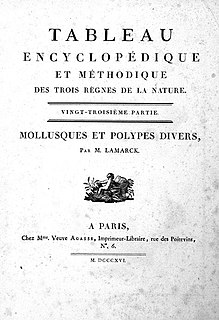
Jean Guillaume Bruguière (1749–1798) was a French physician, zoologist and diplomat.

Guillaume-Antoine Olivier was a French entomologist and naturalist.

The variegated tinamou a type of tinamou commonly found in moist forest lowlands in subtropical and tropical regions of northern South America.

Lumbriculus variegatus, also known as the blackworm or California blackworm, is a species of worm inhabiting North America and Europe. It lives in shallow-water marshes, ponds, and swamps, feeding on microorganisms and organic material. The maximum length of a specimen is 10 cm. Worms raised in laboratory environment are slightly shorter, with 4 to 6 cm long bodies. An adult individual has approximately 150 to 250 1.5 mm wide segments, each of which has the ability to regenerate into a new individual when separated from the rest of the animal. In most populations, this is the primary mode of reproduction, and mature individuals are exceedingly rare; in large areas mature individuals have never been found.
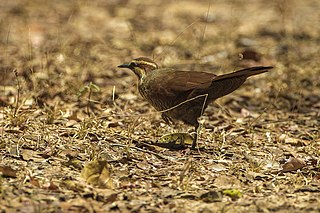
The white-breasted mesite is a ground-dwelling bird endemic to Madagascar. One of three species in the mesite family, Mesitornithidae, it is classified as vulnerable by the International Union for Conservation of Nature (IUCN). It has a small population and is restricted to five sites in the north and west of the island, and one in the east.
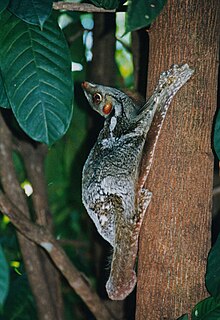
The Sunda flying lemur or Sunda colugo, also known as the Malayan flying lemur or Malayan colugo, is a species of colugo. Until recently, it was thought to be one of only two species of flying lemurs, the other being the Philippine flying lemur, which is found only in the Philippines. This species can be found throughout Southeast Asia ranging from Indonesia, Thailand, Malaysia, southern Vietnam, southern Burma, and Singapore.

The sheepshead minnow or sheepshead pupfish is a species of ray-finned fish in the family Cyprinodontidae, the pupfishes. It is found in salt marsh and estuary environments and is native to the eastern coasts of North and Central America.
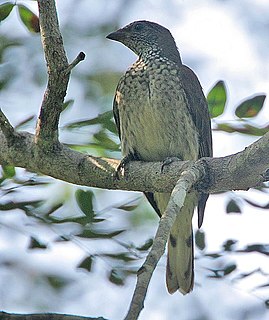
The scaly-throated honeyguide is a species of bird in the family Indicatoridae.

The rock squirrel is a species of rodent in the family Sciuridae and is native to Mexico and the Southwestern United States, including southern Nevada, Utah, Colorado, Arizona, New Mexico, West Texas, and the panhandle of Oklahoma.
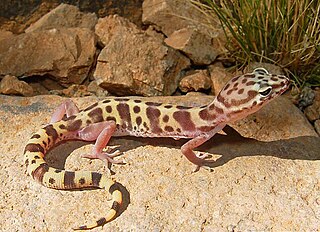
The western banded gecko is a species of lizard in the family Eublepharidae. The species is native to the southwestern United States and adjacent northwestern Mexico. Five subspecies are recognized.

The Angoumois grain moth is a species of the Gelechiidae moth family, commonly referred to as the "rice grain moth". It is most abundant in the temperate or tropical climates of India, China, South Africa, Indonesia, Malaysia, Japan, Egypt and Nigeria, with its location of origin being currently unknown. It is most commonly associated as a pest of field and stored cereal grains as they burrow within the kernel grains of crop plants, rendering them unusable for human consumption. By laying eggs between the grains themselves and hatching at a later time, often during the processing, transportation or storage stages, the moth can be transported to households or countries presently free of Angoumois grain moth infestations. Thus, constant protection against the Angoumois grain moth is required for grain up till the time of consumption.

Prosopocoilus is a genus of beetles of the family Lucanidae.

Oryctes is the most economically important genus of rhinoceros beetles in the subfamily Dynastinae, since it includes a notorious insect pest of palms.
Ceylalictus appendiculata is a species of bee in the genus Ceylalictus, of the family Halictidae.
Ceylalictus cereus is a species of bee in the genus Ceylalictus, of the family Halictidae.
Ceylalictus taprobanae is a species of bee in the genus Ceylalictus, of the family Halictidae.

Bicyrtes is a genus of large, often brightly coloured predatory sand wasps. Many species in this genus provision their nests with paralyzed Pentatomidae, while other species make use of Reduviidae and Coreidae instead.

Oxybelus is a genus of wasps in the family Crabronidae. The species are found worldwide except in the Australasian realm. They are especially represented in the Palearctic. Oxybelus is the largest genus in Crabronidae, with 264 species known. Oxybelus wasps sometimes gravitate towards people, flying around travellers and landing on them, even when they are shooed away. It is not known why they do it, however it might possibly be them trying to drink sweat for its minerals.
Ceylalictus is a genus of wasps belonging to the family Halictidae.















